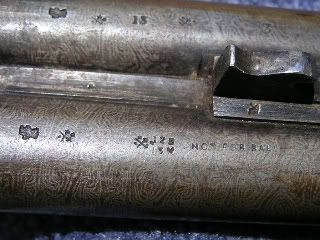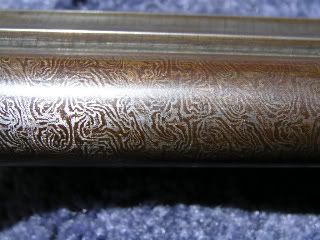It's a double barrel 12 ga. It has a dolls head and two locking bars in the lower receiver. I believe it's called a side lock, with external hammers and double triggers. The barrels are removable. The breech is opened via a lever between the hammers in the conventional manner. It is finely engraved, and checkered, with a horn butt plate. On the right side plate it has "Hy Wynian" engraved, not stamped. On the rib above the barrels is engraved "London, Fine Damascus". Under the fore end are British proof marks; two for each barrel. Along with the proof marks the left barrel is marked "Not for Ball". A few years ago I came across a book of proof marks and learned that the British only used the marking "Not for Ball" between 1887 and 1899, so I have some idea of it's age.
Since one barrel is choked and the other not, I'm guessing it's an upland game gun.
I'm not interested in shooting it, even with black powder, but would be thankful for any further history about "Hy Wynian" anyone could offer. I'm wondering what it would be worth, though I'm not planning to sell it. Thanks to anyone who can shed some light.
We need pictures including the proof marks, to evaluate your gun! With no makers name of;"record" and the words, "London Fine Damascus"' on the rib, it is more than likely an inexpensive gun made for export.Probable source, Birmingham
"Hy Wynian", Is likely the name of the importer or hardware store that marketed the gun. Another outside possibility is that it was the name of the origional owner.
The 'Not for Ball' proof mark was used from 1875 to 1887, not 1887 to 1899, so your gun is a bit earlier than you thought. I agree with Roy Hebbes comments on source and quality. Middle to low grade Birmingham guns were often made without any name on them and a blank panel, the retailer could then order the guns with his name on them or have them 'finished' locally.
The 'Not for Ball' should be associated with a breech and muzzle measurement, eg. 12B, 14M. If this is missing, the Not for Ball may have been applied fraudulently to get the gun into the antique market and avoid restrictions on both the UK and US side of the pond.
Here's a C.F. Leader with Birmingham BP proofs marked "London Fine Damascus"

Makers/distributors marked barrels however they wanted, and in both Liege and Ferlach "London" usually referred to One Iron Crolle-Twist laminate also called Baker "Best London Damascus Twist" and "Barber's Pole"

I see what you mean. The Damascus looks a little finer in the pictures you show. Took me awhile to figure out how to post the pictures, but as you can see it does have the 12B and 13M markings. Very interesting, this is the most info I've been able to gather about this gun. I'm sure you're right about the dates also, it's been awhile since I looked it up in that proof mark book. My brother bought it at a "tag sale" in Mass. many years ago. I don't think he paid much for it. He'll be pleased to hear all this. As I said I'm not looking to sell it but what do you suppose it's worth? Thanks again.
I enhanced your barrel pic a bit and it looks to be a rather messy 3 Iron 'Oxford' or
Damas Crolle' pattern

The name Wyman dose not appear in the records of tradesmen working in the London, Birmingham or U.K.gun trade pre; 1900.
I would agree the gun is of mid range quality, much better than the vast majority of those distributed by H.D.Folsom,of N.Y. It is however typical of guns made for the trade,for example by the, Midland Gun Company, Birmingham.
As anticipated by Toby Barkley, the proof marks are Birmingham black powder, in use from 1875-1887. The right barrel was bored 13G,true cylinder and the left barrel bored 12G but choked to 13G at the muzzle. This results in a choke of .019. [1/2 choke in British terminology].
Will make a nice collectors gun or following a satisfactory inspection by a qualified source a good black powder hunting gun.
I'm confused about what you said about the bores. If the left barrel is 12G and then chokes down to 13G, does that mean the right barrel at 13G is tighter all the way down? A choke of .019 would be what; modified? Wyman not being in the records in the U.K. lends credence to the hardware store theory.
Troublsom 1, check my previous post for R. Grove hammer gun. It is just couple of pages back. That may answer some of your questions. Your gun looks very similar to mine and may have been made by the same manufacturer. Mine seems to be made by Midland. I would like to know if there is a serial number stamped into the steel and also a number stamped into the foerend wood under the left tube. Do the inside of your locks look like the ones in my post?
Yes! The hammers and receiver are the same right down to the engraving pattern. The lock plates are different though, and mine has the same dolls head but without the inlay. My firing pin retaining screw is in a different place also. I can find no serial number but I do have a number in the fore end wood under the left barrel; 19335. If yours is a Midland I'm sure mine is too. I'll take more pictures in the morning
Your gun is probably older than mine. Look at the spread between the numbers stamped in the forend wood. About 6000. If that represents the number of guns made between them that is quite a bit. It is possible that the 6000 guns were not all the same type of gun. There could have been rifles and single barrels mixed in that number. Could you post a close up picture of the horn forend tip Please? Mine is missing but the inletted area is shaped like yours. This will help me when I get around to restoring mine. Is the checkering the same on your stock as on mine? Read all of my R Grove post and you will see why my gun was likely made by Midland and possibly yours also.
Here are some more pictures. I didn't realize the fore end tip was horn till you mentioned it. My top tang is more the normal lenght, but my trigger guard tang is very long. Looks like my locks are something completely different. My right hammer screw is not original, and the left one might not be either. Checkering is different also. There isn't a pointed diamond in the whole bunch. It may not be English but I doubt they were ever pointed up American style. Even considering wear there would be one left pointed somewhere, or at least nearly so. The fore end has 3 screws and only one engraved so I'm sure it's not original either.
I'd like to believe that 19335 is a serial number, and it may be, but it makes no sense to me to stamp it on the wood and not the metal. I've looked carefully though and I can't find any more numbers anywhere.
I've been thinking about your stock crack. I doubt it could be repaired. I've seen some very nicely done repairs on web sites by people who specalize in such things, but they still show if you look close. I would be inclined to replace the whole stock, and to match you'd have to do the fore end also. Any way you go I think it would lower it's value. You might be better off just to leave it alone. Just my opinion.
As far as welding to tighten up the barrel fit goes; I think you might be able to do that. People think of welding and they visualize the worse job they've ever seen with lots of smoke and sparks going everywhere. As I'm sure you know TIG would do the trick, and without melting the soft solder, if you could get to it. I'm thinking of the lugs under the barrels. If you dressed it back down carefully no one would ever know the difference. Trouble is, how would you harden it without melting the solder? I don't think soft steel would last long. Silicon bronze would work and you could dress it down with files but only just, and the color would show. There are hard TIG rods but they can't be filed, and grinding such a thing would be near imposible. Originaly these things were probably case hardened but how would you re-case it without melting the solder? You could work only on the dolls head but that would be only half the job, and what would that do to the inlay? If you decide to try it, use plenty of heat fence, but I don't think I'd risk it.
I've talked this over with my wife, who it happens teaches welding technoligy at the college level, and she agrees. I'd be interested in your thoughts on this.
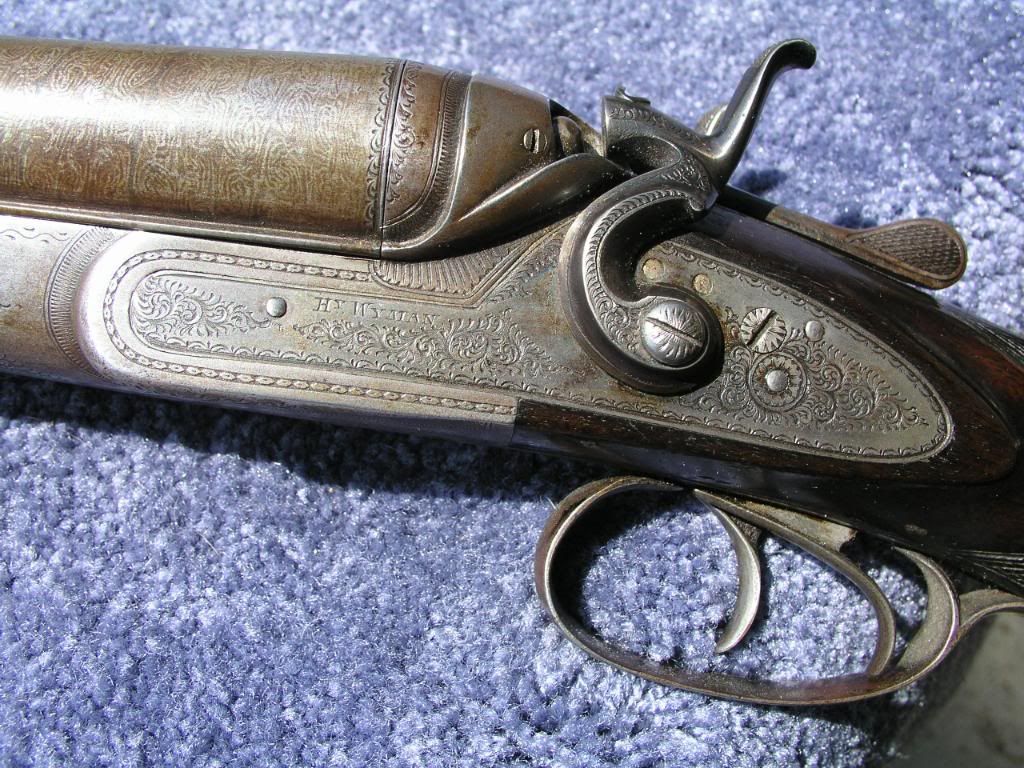




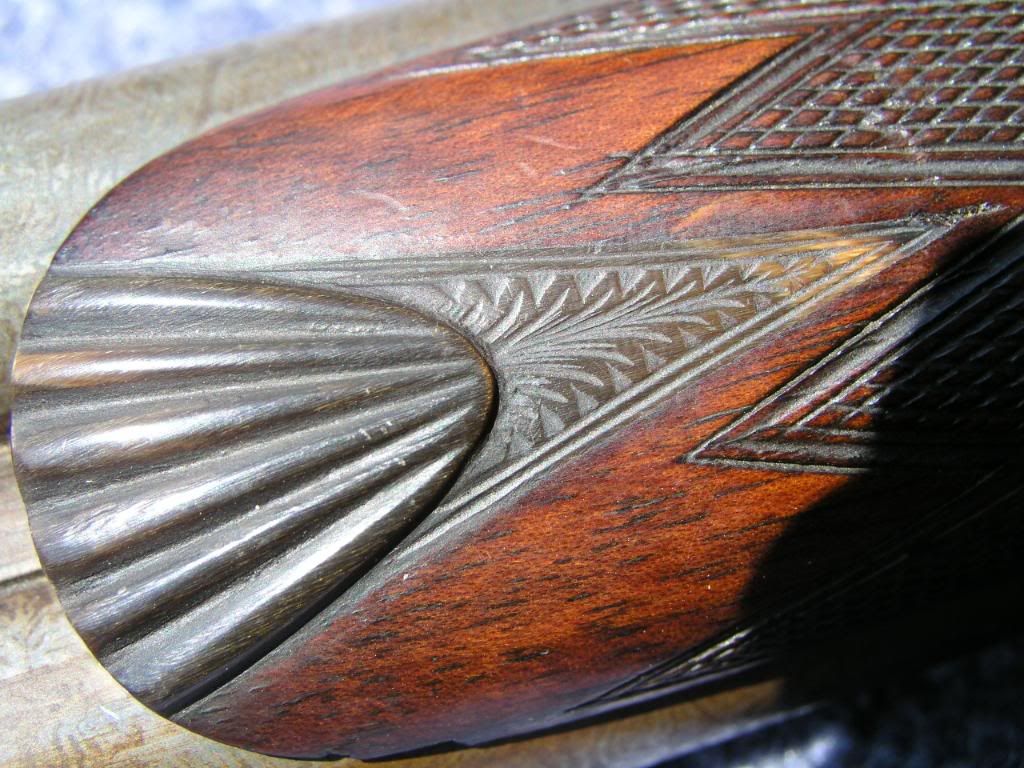

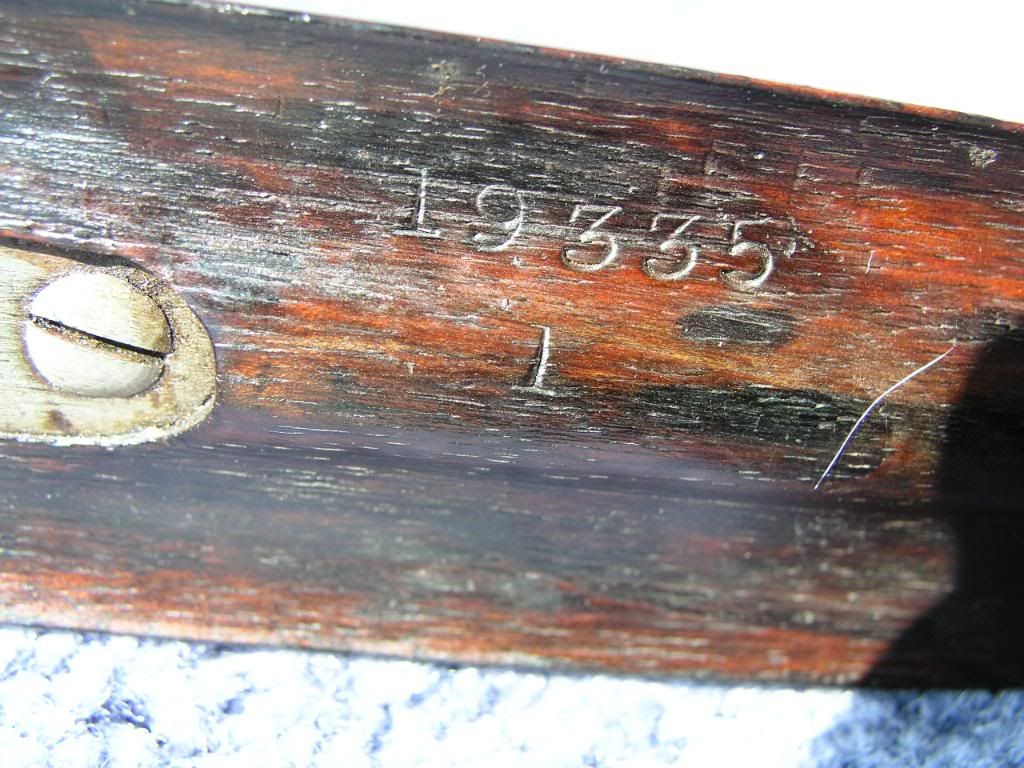
I've been wondering about this old gun for years and now in two days I have answers where I didn't even know I had questions. Does anyone know what the correct resolution size is for pictures, so people don't have to scroll back and forth?
I can't find anything on a Wyman either. However, I'm about 99.9% sure the first name is Henry, the H followed by an elevated y being an abbreviation. Like Wm for William.
In answer to your question re: difference in proof diameters and bore sizes.The right barrel at the time of proof was 13 G [.710 nominal Diameter].There being no choke it was a true cylinder through out its length.The left barrel at time of proof was 12G[.729 nominal diameter] .019 larger in diameter than the right barrel.Per the proof marks,the choke on the left barrel reduces the nominal diameter at its muzzle to 13G [.710 diameter] To better understand allowed variation in diameter relative to stamped bore size, you need to refer to the rules/scale of proof applicable to your gun; these can be found in W.W.Greeners book, "The Gun" on pages 300-302
The difference in bore size is in fact a clue to the fact that gun was made for the trade. The gun, could for example have been finished with both barrels bored cylinder @ 13G; a popular combination in the Victorian era. To convert it to a gun with a choke in the left barrel, all that was required was to open up the left barrel to 12G! This was a method that could be used to minimise inventories and provide quick delivery on special orders.
troublsom1, I don't know about the stock crack on my gun but I've seen some of these guys do some pretty nice work with cracks such as this. If it's not possible I am capable of making a replacement stock for it. Putting a gun back on face by building up the hook is becoming a mainstream technique. It may not be right for every gun but for some it is the only practicle way. There was a nice discusion about that a few months back on here. A gun with a dolls head and a hinge pin like these guns have is a good example. Yes you can replace the hinge pin but after figuring out how the old one comes out,pressing it out, pressing a new one in and re-engraving, welding and dressing I believe would be qicker. It would also keep the character of the gun intact. I am a professional welder and am capable of this job. I have already done this. The hook is NOT case hardened as you suggest. Infact many guns of this time frame had the hook brased to the barrels and on some old guns you can see a greenish line where the joint is. Using brazing rod is not the way to go either unless you want to look like bubba the gunsmith. When welding the hook the key is not to rush it. Weld a little and let it cool and repeat as many times as is necessary. On guns with a dolls head, the dolls head is the benchmark. Building the hook so that the dolls head does not have to be messed with. But all old guns are individuals and sometimes the extension is worn also. It is possible to build this up also but having modern welding equiptment makes this possible,control is everything. I know a man with a square wave tig machine that welded two razorblades together. I believe that standard 70s filler is good enough for this job but there may be some more suited and wear resistant. A higher silicone rod may be in order to clense the old steel. I will experiment with some different filler rod when I am ready and choose what I think is best. After all there are no standards on this and these are not going to be used as trap guns.
I understand. I thought you were going to weld on the dolls head and the two lugs that engage the two bars in the receiver, for some reason, and this is what I discussed with my wife. Took me awhile to figure out what you meant by the hook. Now I see. Of course, what you're saying makes perfect sense, and would be much easier than replacing the hinge pin. Thanks for enlightening me.
Just for fun I measured the barrels on my gun. The left barrel is .733 at the breech just in front of the chamber, .728 at 4 inches from the muzzle and .715 at the muzzle. I may still be measuring part of the choke at 4 inches but over all it's .018 of choke; pretty close to what it's suppose to be. The right barrel is .725 at the breech end, .725 at 4 inches from the muzzle and .730 at the muzzle. That's .015 bigger than it's suppose to be, but after all it was built "for the trade".
I have seen Hy used as an abbreviation for Henry. I've been looking on the web but see no Wyman companies around the right dates.
Don't forget that at the time this gun was proofed precise measurements of bore & choke were not made. A series of plugs were used to check the bore. The right bbl accepted a 13ga (.710") but not a 12ga (.729") so actual size could have been anywhere in between. The left bbl accepted a 12ga plug at breech but not an 11ga (.751")one & a 13ga plug at the muzzle, but not a 12ga. One thus cannot state precisely what ctual measurements were at time of proof, only that they fell within that range.
I measured the chamber length of this thing. They're right about 3 inches. So, a 2 3/4 inch shell would work. I'm thinking they are made for the American market. I read somewhere that English shells of the period were 2 1/2 inches.
Does anyone know anything about the locks? What type are they? Since there are screw ends showing behind the hammer there must be parts attached back there, so I'm guessing the main springs are forward of the hammer. You guys seem pretty knowledgeable about these things, can anybody shed some light on this?
I'm wondering what it would be worth, though I'm not planning to sell it.
I'll take a stab at it...
$500 or less to a knowledgeable double gun guy a $750 to $1000 to the less knowledgeable.
Proof diameters are measured and apply only at a point 9 inches from the breech.A 13G OR 13/1 gun would be deemed in proof upto.728 diameter maximum.When the size reached .729 diameter the right barrel would be declared," out of proof" and would require reproof as a 12G. In so far as the larger diameter measured at the muzzle of the right barrel; this could be an attempt by the manufacture or some other at a later time to increase the shot spread.
There should be included in the proof marks on the barrels, a stamped diamond, inside of which will be found the symbol 12/C. this is the mark that confirms the gun was chambered for 2 1/2 shells. If the diamond includes the symbol 12/LC the gun was chambered for shells longer than 2 1/2. Frankly I will be surprised if this is anything but a 2 1/2 chambered gun. So many time I have seen old guns rendered out of proof because the chambers have been extended.[Some old time gun smiths thought that by increasing chamber length they made the barrels/gun safe for shooting 2 3/4+ shells,instead they rendered the gun "Out of proof"!]
Looks like it will be a Bar Action as the pin for the mainspring is visible in the forward part of the bar. Chamber length will, most probably be 2 1/2", or at least that is the length of cartridge it was intended for. Some I have seen of that era made for the 2 3/4" cartridge were marked as such on the forend lump of the barrels. I don't think 3" chambered 12 bore guns existed at that time. It could be a product of the Midland Gun Co. except for the proof marks dating to 1887 because the MGC. didn't come into being until 1889. Some of the features are not dissimilar to those made by W & C Scott of that period. It's not unlike th Model 67 made from 1885 to 1914, especially the strikers, hammers and fastening. I'll have another good look at the photos, but that is my leaning on this gun. Scott's made guns for the Trade. I still come across a good many guns that I find unlisted as to the name on the action. Quite a few were sold by small country hardware stores who put their name on or even by individuals. Lagopus.....
Roy, When I measured the chamber length before I was guesstimating with a 6" scale. When I measure with a proper tool it comes to 2.675. A fired modern 2 3/4" shell comes to 2.655. So, it must be made for 2 3/4 in shells. I've crawled all over this thing with a magnifying glass and can't find any markings as you describe. There is a tiny mark on the fore end lump, but I can't make out what it is. It shows in the first set of pictures.
HomelessjOe, Thanks for the guess on the price. I think my brother paid less than $100 for it maybe 15 years ago.
lagopus, I think the "NOT FOR BALL" is authentic as it is accompanied by the 12B and 13M markings, and the alignment and spacing are right. I don't think it was made at a later date with separate letter stamps. Therefore, I think the date range of 1875 to 1887 is probably correct. Which would mean as you say it wasn't made by Midland. Tanky's gun is so similar to mine it's hard to believe at least the receivers were not made by the same company. Mine is evidently a few years older than tanky's. I think his gun also has the "NOT FOR BALL" mark, which would mean nether gun is a Midland since they wouldn't have used that mark in 1889. Could you post some pictures of W&C Scott guns? Thanks.
That was no "guess on the price"...if anything it was on the high side.
That gun might have been built down the road from W.C.Scott but it's no Scott.
How can you be so sure without even looking down the barrels? Wouldn't that make a big difference?
I own several W. & C. Scott's from this same time period...from what I can see of the quality of the gun I'd almost bet the gun or parts were of Belgium origin....
but you're not interested in selling so what does it matter ?
troublsom1-Pay attention to lagopus. He's knows what he's talking about. I'd pay a lot less attention to what some others are saying. (HJ comes to mind.)
Good point about Tanky's gun even though the standard form of the gun points to Midland. Your proof marks look fine. I was thinking along the lines of a 'C' Quality Model 67 Scott. They came in all grades. Can't see anything that points to Belgium in there. Like a lot of these old guns; they remain something of an enigma. Lagopus.....
jOe, In the last few minutes I've looked at several W & C Scott guns on the internet, and they all do appear to be higher quality than my gun. It's hard to say from only looking at pictures, and I have none of your obvious experience and expertise. Though, there are similarities, and lagopus says Scott also made made guns "for the trade". Your price was from $500 or less to $1000 which I thought was an estimate, and appreciated the effort, but that could mean anything form a penny to $1000. I suppose with such a broad range, one could consider it firm. Of course it doesn't matter, and it's not mine to sell even if I wanted to. I'm only curious about this old gun. My questions aren't meant to disparage anyone's judgment. I'm just trying to learn what I can. No offence intended.
So, if it's too early to be a Midland, and too crummy to be a Scott, even a "for the trade" Scott, what is it? If it's Belgian, why the Birmingham proof marks? Are there Belgian guns out there more similar to mine than the Midlands and Scotts I've seen?
Lagopus, From the pictures I've seen so far I think tanky's gun may well be a Scott. The engraving on mine looks more generic than his, and his firing pin screw is in the right place for the Scotts I've been looking at, as well as the shape of his lock plate. Have you seen Scotts with the firing pin screw like mine? Sure would like to see a few pictures of that "C" Quality Model 67 Scott. Think I'll take another run at the internet and see if I can find one. Thanks.
I found one at: html//www.cabelas.com/gun-inventory---scarborough---english-sg---932981-wcsct-sca.shtml, I just ran a Google search for W & C Scott shotguns, and it was about the 8th one down the page. Similar to mine but again the firing pin screw is different. This is the closest lock to mine I've seen yet. The forward edge just in front of the hammer is curved though like tanky's whereas mine is angled. This one is suppose to be 1882. I wonder if they used different locks thought the years.
Note that the chamber marking 12/C in a Diamond did not appear until 1887, nor did the intermediate gauge markings as 13/1. The markings on your gun appear absolutely correct for an 1875-1887 Birmingham blackpowder proofed shotgun.
The fact that your gun chambers a modern 2 3/4 shell dose not mean it is safe to shoot modern 2 3/4 smokles shells; to do so is to court disaster!The breech pressure developed by most modern smokless, 2 3/4 shot gun shells, is in many cases equal to,or greater,than the proof pressures generated by the original black powder proof test. Prior to shooting smokless loads in any black powder gun it should first be submitted for nitro reproof.
For the record, at the time when your gun was made a 2 1/2 inch and 2 3/4 inch black powder shell with rolled turnover, did, believe it or not, measure 2.5 and 2.75 inches in length! From this you should be able to appreciate the fact that if you tried to chamber a 2.75 B.P. shells in your gun you would not be able to close the action!
Strongly recommend that you abandon the "fishing trip" and send your gun to a competent gunsmith who is properly equipped to acurately measure and evaluate the condition your gun.
Amen
Case closed....and it wasn't built by W&C Scott.
Relax everybody. I said early on that I had no intention of firing this thing with smokeless, black or otherwise. Never considered it for a moment. Don't know how you got the idea in your head. I did say that I thought it was chambered for 2 3/4 inch shells, and now that you mention it I'm probably wrong about that. It's more likely meant for 2 1/2 inch shells as Lagopus says, though it would chamber a modern 2 3/4 inch, the chamber is not quite long enough for the unfolded crimp; close but not quite. As I'm sure you know it's the unfolded length that is important. It really makes no difference how long it is when it goes in, no matter what kind of crimp it has.
I'm still interested in finding out who the maker was and any other information I can get. I started this as a search for knowledge, not a fishing trip, and I've learned a lot in the last couple of days.
At first I thought it was a Midland but it appears too old for Midland. It may be Belgian but knowledgeable people here doubt that theory, so for the present I must discount that. The 12C inside a diamond appears to be irrelevant, except that it means it was made prior to 1887. In my mind Scott is still a possibility though it doesn't appear to be the 1882 model C that I saw online. I have yet to see a "C" Quality Model 67 Scott however, and it could even be another model Scott. So, my mind remains open, and the search for knowledge goes on. One thing I want to make clear, and respectfully so. I have no intention of getting into some sort of online pissing contest over it.
Relax everybody. I said early on that I had no intention of firing this thing with smokeless, black or otherwise. Never considered it for a moment. Don't know how you got the idea in your head. I did say that I thought it was chambered for 2 3/4 inch shells, and now that you mention it I'm probably wrong about that. It's more likely meant for 2 1/2 inch shells as Lagopus says, though it would chamber a modern 2 3/4 inch, the chamber is not quite long enough for the unfolded crimp; close but not quite. As I'm sure you know it's the unfolded length that is important. It really makes no difference how long it is when it goes in, no matter what kind of crimp it has.
I'm still interested in finding out who the maker was and any other information I can get. I started this as a search for knowledge, not a fishing trip, and I've learned a lot in the last couple of days.
At first I thought it was a Midland but it appears too old for Midland. It may be Belgian but knowledgeable people here doubt that theory, so for the present I must discount that. The 12C inside a diamond appears to be irrelevant, except that it means it was made prior to 1887. In my mind Scott is still a possibility though it doesn't appear to be the 1882 model C that I saw online. I have yet to see a "C" Quality Model 67 Scott however, and it could even be another model Scott. So, my mind remains open, and the search for knowledge goes on. One thing I want to make clear, and respectfully so. I have no intention of getting into some sort of online pissing contest over it.
Sorry everyone, I guess I hit the submit button twice.
You are absolutely correct about the nominal length of a shotshell being its fired length, not its loaded length, & unless excessively long a shell longer than gun is chambered for can normally be loaded with no signs for detection. It should be noted though no shell should be used in which the loaded length of the shell actually enters the cone. This can cause a resistance in opening of the crimp & bring on a drastic increase of pressure. This is most apt to occur using roll crimp shells being about ¼" longer than chamber. Also many British "2½" guns will have chambers of 2 9/16" (65mm) length or even 2 5/8". I know you said you are not planning on firing this gun, but it does need to be pointed out for certain a shell, particularlly a fold crimp as most present day shells are, can be loaded freely in a chamber considerably shorter than the nominal length of the shell with no resistance to show it. This does not mean the "Should" be shot, but they quite definitely "Can" be.
I agree. The danger is in loading a shell who's uncrimped length is too long for the chamber. Roll crimped shells will be longer than folded crimped shells even though they both started out at the same length before being crimped. If the crimp unfolds or unrolls, as the case may be, into the cone, it will cause a constricted area and pressure will spike. I used to hunt deer in Iowa with a man who one day inadvertently grabbed a handful of 3" slug loads and fired them in his 2 3/4" gun. He got away with it, without ill effects, but it's certainly not a practice to be recommended. Also, I agree that smokeless loads should never be fired in a black powder proofed gun, Damascus barreled or otherwise. When I measured my chambers with a proper tool I learned that they were indeed too short for a 2 3/4" shell. They are in fact 2 5/8". Though I could probably cut off and skive, and then load 2 1/2" black powder shells for this gun I have no need, desire, or intention of doing so, and never did. Ever!
I just chambered and closed the breech on an old 2 3/4" 12 ga. roll crimped shell. As I said my chambers are long at 2 5/8". It's very old but I think it is loaded with smokeless powder. To fire this shell would be very dangerous, but I had no trouble closing the breech. But, a 2 3/4" shell is a 2 3/4" shell no matter what it"s loaded with. A roll crimped shell is of course longer than a folded crimped shell in the unfired condition. Once they are fired they will be the same length. The have to be; otherwise they are not 2 3/4" shells.
Your gun has some engraving under the breech balls that is similar to some JP Clabrough guns...which most, if not all were Birmingham proofed(regardless of the LONDON stamped on the ribs). The wood carving is a bit european, but I have a Clabrough that has a carved POW grip, go figure.
As 2piper said, it has the right proofs.
We see some similarities to other guns from the same time period and place of proof as well...might have been the English version of a "hardware store gun"?
Suggest a search for the name without a gun variable......might turn up as a general merchant. Might then back track to who made the guns?
Birmingham would seem to have been quite the "trade" back then, and who knows who traded what for what....would not count on finding out who made it. Might figure out who's casting the action was, who's locks....who engraved....
Search the name?
Best,
Mark
I tried searching for the name without a gun association as you suggest. Tried Wyman Company, Henry Wyman, Harry Wyman, etc. no luck. I get hits but nothing that points to guns, or hardware. There is a Wyman and Sons Ltd, London, but it's 1902 and seems to be no association with guns. Have seen several guns that show similarities but nothing dead on yet. The Scotts are very close, but I can't say for sure. Seem to be several with almost identical receivers. Tacky's R.Grove gun is very close, but different locks. I think it is a hardware store gun. I'll look up JP Clabrough tomorrow. I have learned here that it is a bar action side lock, with Birmingham proofs, made between 1875 and 1886, but may never know who made it. Any idea how to find out who cast the action, or made the locks without removing them? I'm kind of scared to try to remove the locks. A broken screw would be disastrous. What's a POW grip?
This is about the best I can come up with for a 'C' Grade Scott:
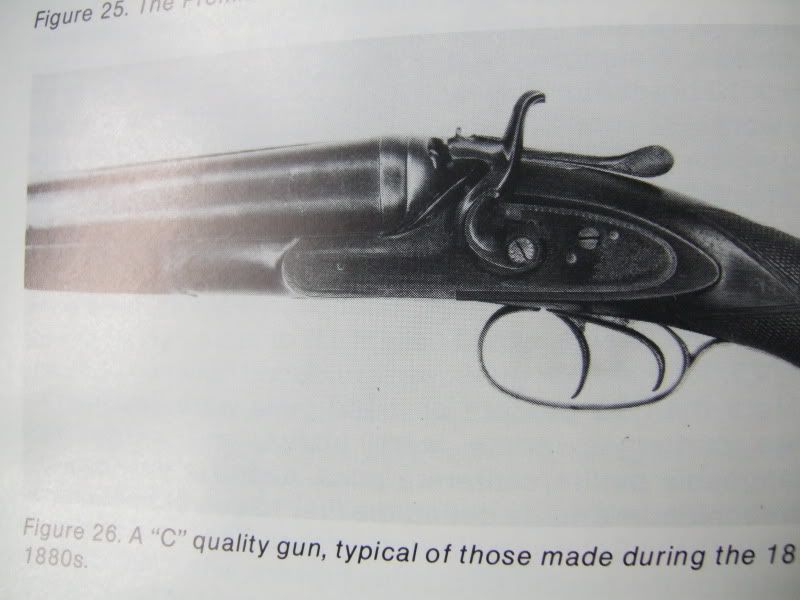
It must be remembered that identifying the Maker on some of these guns is just an educated guess based on certain features and general style. Often there were variations within the same model over a few years of time and being largely handbuilt there could be a lot of variation that way. The Strikers are very like those used by Scott on a number of his guns as are some of the other features on your gun. Guns by Bonehill also had similar srtikers on some models. Sometimes, when I get them in my hands the Maker becomes quite obvious. I only wish that a Gunsmith friend of mine would come out of the 19th. cent and into the 21st. and get on these forums. He will often look at a gun and see a couple of initials on the barrels and be able to say who the person was who worked on the gun and which firms they worked for. Sort of like Masonic symbols known only to pratitioners of that craft. You may not find an exact match to your gun in all the details because of the hand crafting that went into them and sometimes you may find a hybrid model with features from one and features from another as they would supply whatever was in demand by the person ordering the gun. Lagopus.....
The hammer in the picture looks very much like mine. But the firing pin screw and the curved edge of the lock plate are different. The receivers, and triggers are very close. As you say I'll probably never know for sure. The lack of a 12C inside a diamond and the NOT FOR BALL mark narrows it down to 1875-1886. I know it was proofed in Birmingham, and it is a bar lock action, chambered for 2 1/2" ammunition. Maybe someday someone will run across a gun with the angled edge to the lock plate, which seems to be a unique feature of my gun, and we can stir up the conversation again. I've learned a lot considering. Many thanks to all.
Alright folks I took this thing apart. I thought I would give it a try and if I encountered any resistance I'd quit and reverse course. It came apart remarkably easy. I've had much newer guns give me much more trouble.
I had hoped to find some sort of mark inside that would help identify the maker, but came up empty. There is not a mark, stamp or initial anywhere inside this thing. I did see a pair of notches on various parts, and screws. They appear to have been made with a graver as they are too sharp for a file. I think they are just marks made at the bench to identify which hand fitted parts go with each other.
I did clean all the parts in acetone and scrubbed them with a paint brush. I oiled everything with Break Free and blew off all the excess with compressed air, so it's cleaned and oiled now at least. I was very surprised at how little rust there was inside and the wood isn't oil soaked like a lot I've seen.
There is a mark on the fore end lug that I'm not sure about. It looks like a V of some sort, but seems a little strange for a V. Maybe it's just the angle the stamp was at when it was hit with the hammer.
On the sides of the fore end release lever it shows a crown, or something, and Patent on one side and something like EY & EDQE as near as I can tell, on the other. There may be more to the left of the E but I can't make it out. Maybe Largopus can shed some light on it. If it's an English patent perhaps it will narrow the date range at least.
Also I see that the screw that goes through the upper tang under the breech opening lever appears noticeably off center, and is threaded into the same hole as the separate screw that holds on the trigger plate.
Thanks again to all.
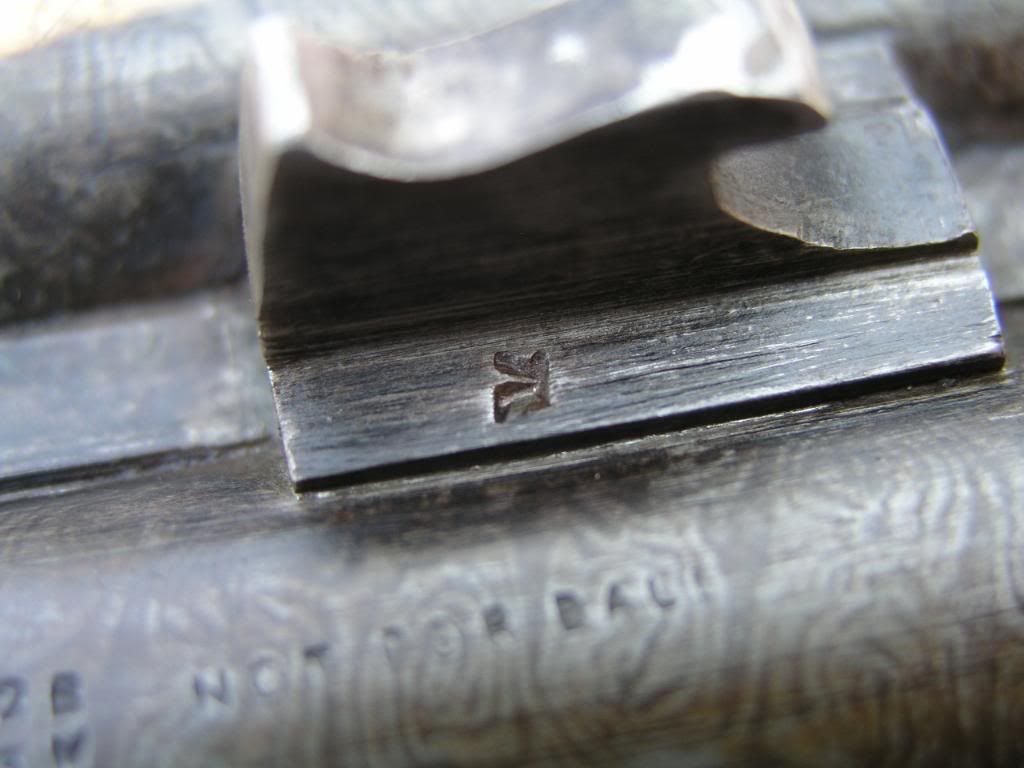
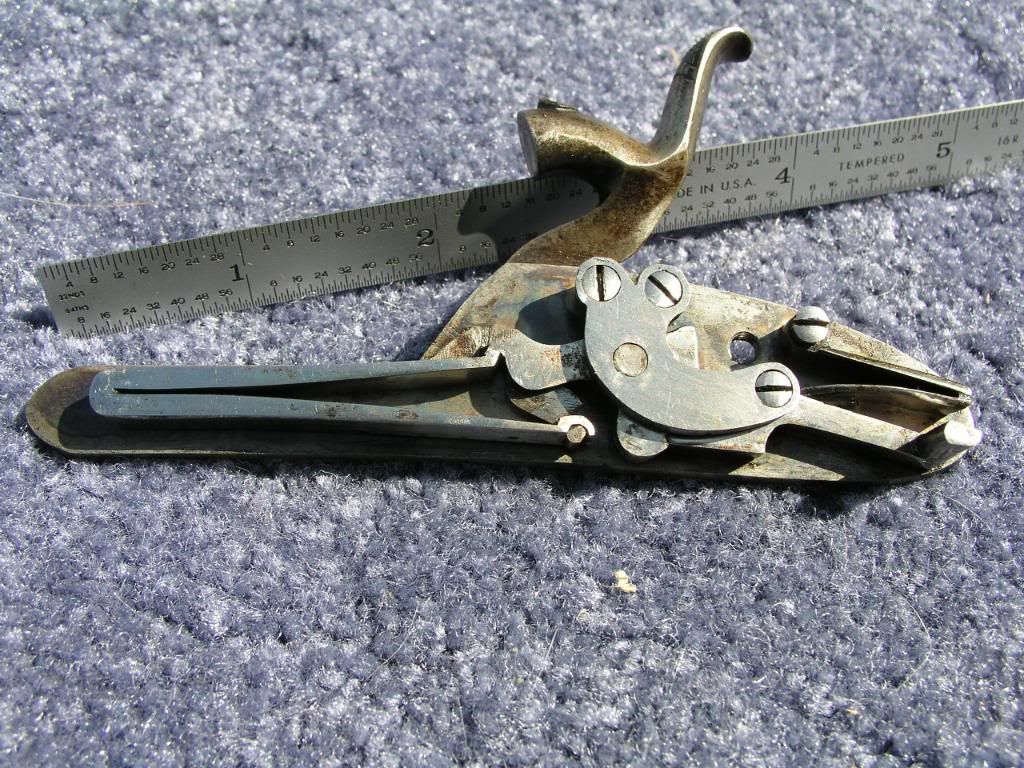
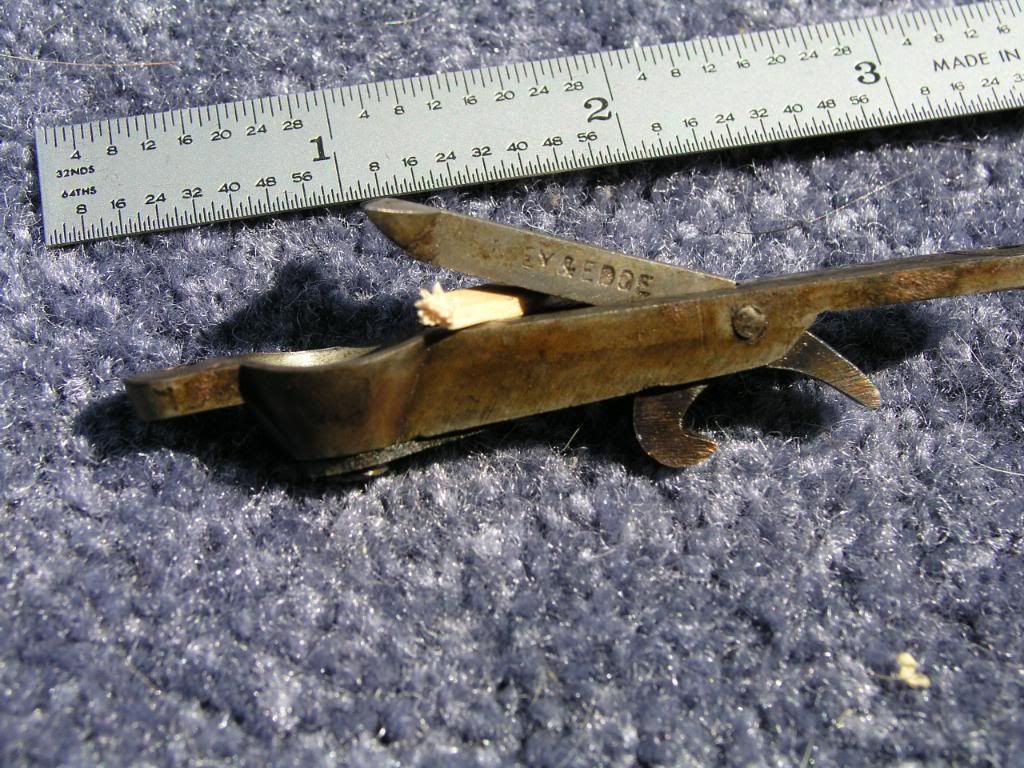
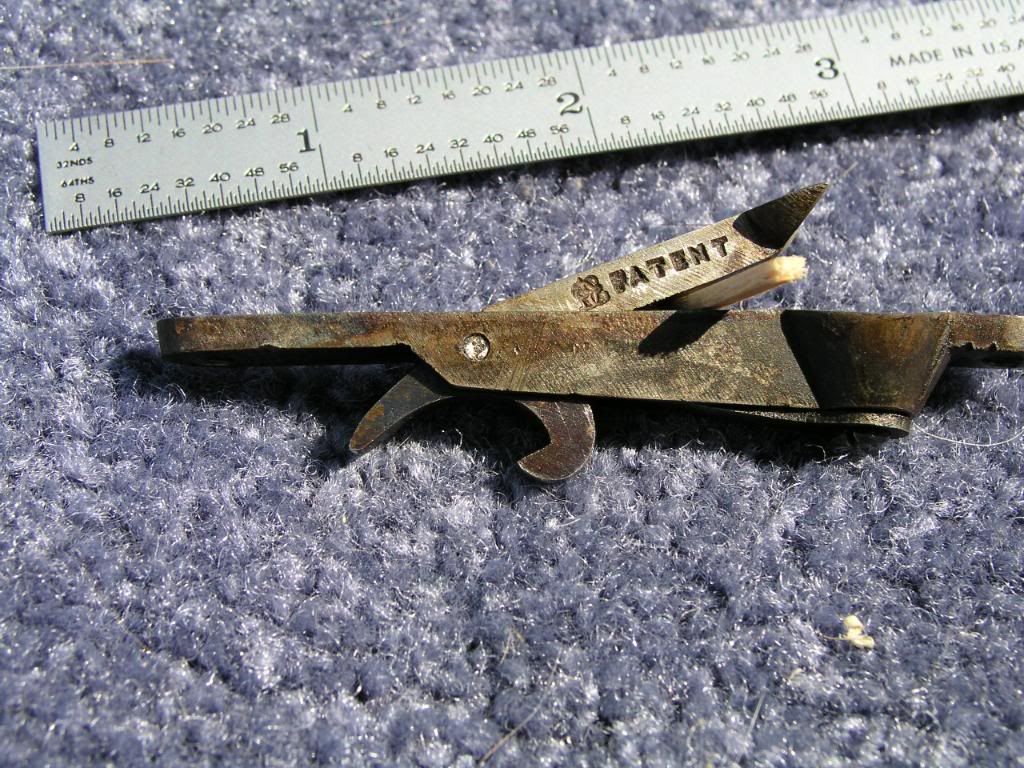
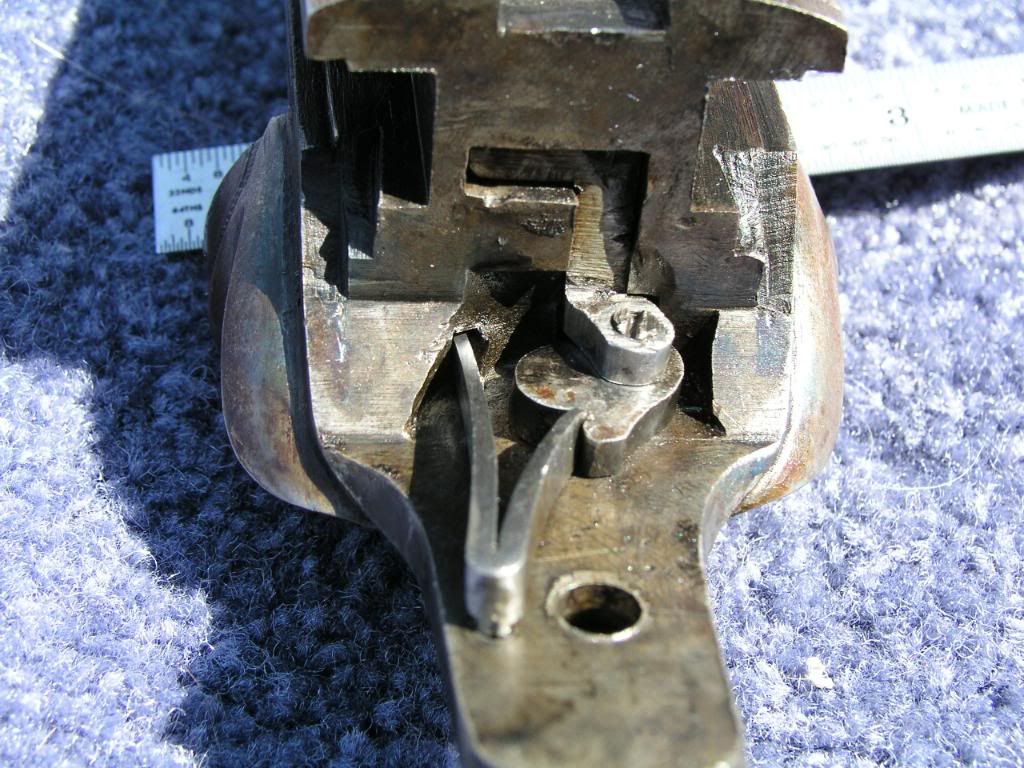
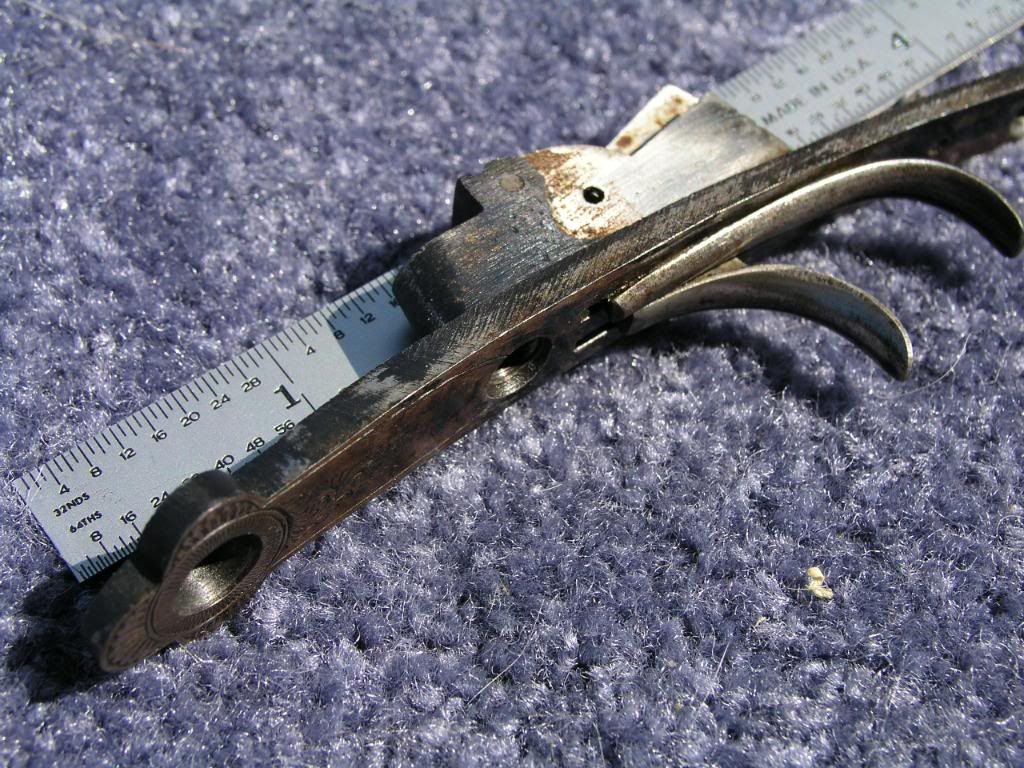
The writing on the fore end lever is most probably Deeley and Edge. They have patent 1422 of 1873 for "vertically sliding breech block and fore-end attachment for drop down guns". (source: Brown's London Gunmakers).
I thought it was something and EDGE at first myself, but I'm pretty sure it's a Q and not a G. I'm probably wrong but just to be sure, I think I'll take it back apart in the morning and look again. It must be a G; a Q wouldn't make any sense. Since we know this thing was made somewhere between 1875 and 1886. I wonder if the style of lock would narrow it down any. Is this an early type or later; or would they just use whatever?
I looked again. Let's call it a smudged G.


